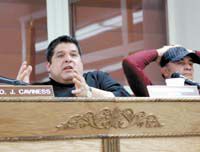| Mayor Orlando LaFontaine and Councilmember David Maggio discuss the plan for an interlocal agreement with East Carbon City residents. East Carbon and Sunnyside city are trying to work out an arrangement that would bring the municipalities fire departments together in order to bolster their chances of having a new public safety building funded by the Permanent Community Impact Board in during the April session. |
During a regularly scheduled council meeting on Jan. 9, a community coalition addressed East Carbon officials concerning a joint public safety building proposed for the city and Sunnyside.
The Utah Permanent Community Impact Board refused to allocate monies for the proposed East Carbon-Sunnyside safety building during the state agency’s December funding meeting. The cities were placed on the pending list at that time.
“A $1.5 million dollar grant with no matching portion has never been given to a rural community by the CIB,” said Sandra Garcia, of the East Carbon-Sunnyside Community Coalition. “I have talked with commissioner Milovich and he stated to me that the CIB wants the cities to completely combine departments before they will allocate this funding. Our town needs this not only for the fire departments, but for the ambulance service.”
“Ambulance personnel have advised me that, if there is a problem with the battery on the number one Sunnyside ambulance during a call, then there would be no expedient way for them to get the back up out of the current facility,” continued Garcia.
Combining the departments has proven to be a difficult task for the two communities.
“I knew in February 2005 that our public safety plans would not fly if we were not one department and I was told that Sunnyside did not want us on their project at that time. So we hired our own architect to work on our own public safety project. It was only after the CIB told us that we needed to come together in early 2005 that Sunnyside let us in on the current project. But logistically, combining the departments is a difficult thing. I have never heard of two cities joining departments and not forming a fire district,” said East Carbon Mayor Orlando LaFontaine.
“I would like to see us concentrate on getting an agreement together that puts both departments under one roof, take that to the CIB and then ask them what it is that they want exactly,” continued LaFontaine.
According to East Carbon fire chief Darrel Valdez, the members of his department have concerns about a combined department.
The concerns include how the chief and assistant chief would be selected and how equipment would be used between the two municipalities.
The interlocal agreement draft that East Carbon and Sunnyside have been working toward stipulates that:
•Both cities shall cooperate in financing, constructing and using of the proposed public safety building.
•The interlocal cooperative agreement and does not create any separate legal entity.
•Pursuant to Utah law, a joint board shall administer the agreement and have management power over all matters related to the public safety building.
•The joint board shall consist of the two mayors along with one councilmember and one citizen from each city.
The citizen representative will be mutually agreed upon by the board.
•The joint board shall be responsible for approval and oversight of architectural and construction matters.
•The public safety building shall house only the fire departments of each city and the Sunnyside ambulance.
•The agencies to be housed within the public safety building shall be referred to as the East Carbon and the Sunnyside fire departments.
Each city will be solely responsible for the administration and covering the costs associated with the town’s fire department.
•The property on which the public safety building will be constructed will be deeded to both cities
•Ambulance administration and costs shall continue to be the responsibility of Sunnyside.
•The cities agree to share the cost of operation, maintenance and insurance of the building equally, with the exception of utilities for the ambulance portion of the building.
The right to contact the architect has been a sticking point. Until last week, Sunnyside had denied East Carbon access to the architect who designed the proposed building, citing increasing cost as a reason.
Sunnyside Councilmember Sherry Madrid was in attendance at the East Carbon meeting on Tuesday. According to Madrid, Sunnyside has given the firm’s information to East Carbon with the stipulation that any changes to the building would have to be approved by city councils.
This is a step toward getting an agreement signed considering that members of the East Carbon council have stated there is no reason for the cities to try to hammer out an agreement without the presence of the architectural firm.
But reaching an interlocal agreement may not resolve the issue, according to Carbon Commissioner Mike Milovich, who sits on the CIB board.
“The CIB told both mayors during the funding meeting in December that sharing a common building as two separate departments would not be enough. They were told to combine their departments to encompass personnel, facility, equipment, finance and administration if they wanted this grant,” said Milovich. “If they go to the board with a hybrid agreement that does not combine their departments they will be told to come back when they can get their act together.”

